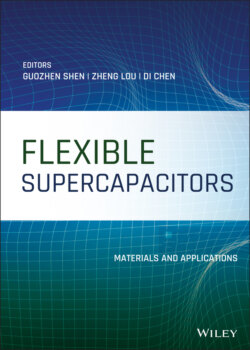Читать книгу Flexible Supercapacitors - Группа авторов - Страница 15
1.3.1.2 Transition Metal Oxide Anodes
ОглавлениеTransition metal oxides can generate reversible redox reactions on the surface or even in the bulk during charging/discharging, which results in much higher capacitances compared to carbon‐based anodes. By integrating transition metal oxides with flexible current collectors as pseudocapacitive anodes, the energy density of AFSC can be drastically enhanced. For example, Yang et al. [54] grew α‐MnO2 nanowires (NWs) and amorphous Fe2O3 nanotubes (NTs) on flexible carbon textile as the pseudocapacitive cathode and anode respectively (Figure 1.5a) to fabricate a sandwich‐type flexible asymmetric pseudocapacitor (Figure 1.5b). The as‐fabricated sandwich‐type AFSC operates at a maximum cell voltage of 1.6 V (Figure 1.5c) and delivers high energy density of 0.55 mWh cm−3 (Figure 1.5d). Two devices connected in series can readily operate a blue LED after charging (Figure 1.5d inset), indicating the potential of the AFSC in future applications. Similarly, a novel flexible all‐solid‐state asymmetric SC fabricated with a carbon‐fabric‐loaded WO3–x/MoO3–x core/shell nanowires anode and a polyaniline cathode was reported by Xiao and his co‐workers. The device showed satisfactory energy density (1.9 mWh cm−3), impressive cyclic stability, as well as good mechanical flexibility.
Figure 1.4 (a) Schematic diagram of the CC activation process. (b) Galvanostatic charge/discharge curve and potential distribution curve for the MnO2@TiN//EACC device at 6 mA cm−2. (c) A LED indicator powered by the tandem straight and bended MnO2@TiN//EACC devices.
Source: Reproduced with permission [90]. © 2015, Wiley‐VCH.
